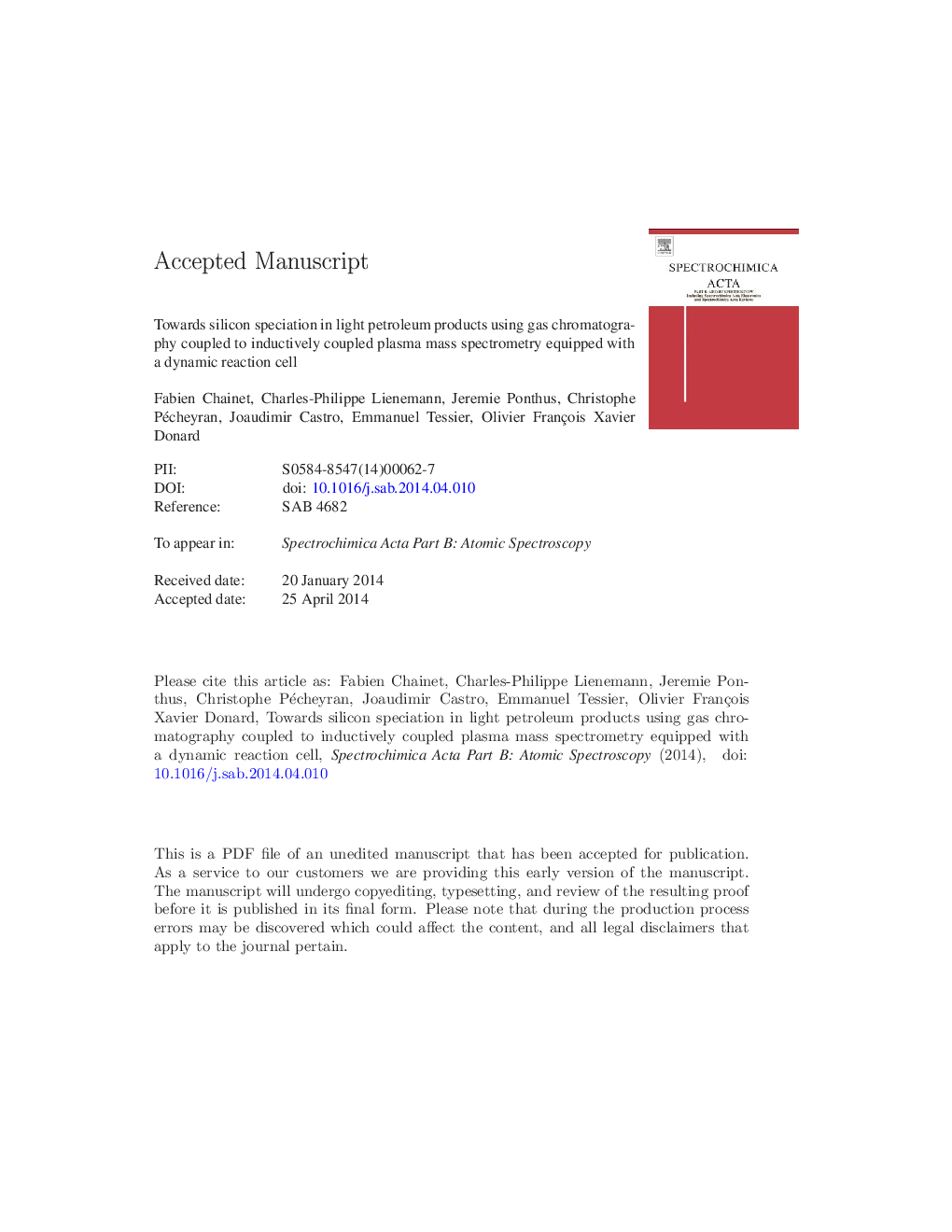| کد مقاله | کد نشریه | سال انتشار | مقاله انگلیسی | نسخه تمام متن |
|---|---|---|---|---|
| 7674732 | 1495705 | 2014 | 25 صفحه PDF | دانلود رایگان |
عنوان انگلیسی مقاله ISI
Towards silicon speciation in light petroleum products using gas chromatography coupled to inductively coupled plasma mass spectrometry equipped with a dynamic reaction cell
ترجمه فارسی عنوان
به سوی تولید سیلیکون در محصولات فرآورده نفت سبک با استفاده از کروماتوگرافی گاز همراه با اسپکترومتری جرم پلاسما همراه با القایی مجهز به یک سلول واکنش پویا
دانلود مقاله + سفارش ترجمه
دانلود مقاله ISI انگلیسی
رایگان برای ایرانیان
کلمات کلیدی
سیلیکون، خاصیت، فرآورده های نفتی، کروماتوگرافی گازی، طیف سنجی جرمی پلاسما به صورت القایی،
موضوعات مرتبط
مهندسی و علوم پایه
شیمی
شیمی آنالیزی یا شیمی تجزیه
چکیده انگلیسی
Silicon speciation has recently gained interest in the oil and gas industry due to the significant poisoning problems caused by silicon on hydrotreatment catalysts. The poisoning effect clearly depends on the structure of the silicon species which must be determined and quantified. The hyphenation of gas chromatography (GC) coupled to inductively coupled plasma mass spectrometry (ICP-MS) allows a specific detection to determine the retention times of all silicon species. The aim of this work is to determine the retention indices of unknown silicon species to allow their characterization by a multi-technical approach in order to access to their chemical structure. The optimization of the dynamic reaction cell (DRC) of the ICP-MS using hydrogen as reactant gas successfully demonstrated the resolution of the interferences (14N14N+ and 12C16O+) initially present on 28Si. The linearity was excellent for silicon compounds and instrumental detection limits ranged from 20 to 140 μg of Si/kg depending on the response of the silicon compounds. A continuous release of silicon in the torch was observed most likely due to the use of a torch and an injector which was made of quartz. A non-universal response for silicon was observed and it was clearly necessary to use response coefficients to quantify silicon compounds. Known silicon compounds such as cyclic siloxanes (D3-D16) coming from PDMS degradation were confirmed. Furthermore, more than 10 new silicon species never characterized before in petroleum products were highlighted in polydimethylsiloxane (PDMS) degradation samples produced under thermal cracking of hydrocarbons. These silicon species mainly consisted of linear and cyclic structures containing reactive functions such as ethoxy, peroxide and hydroxy groups which can be able to react with the alumina surface and hence, poison the catalyst. This characterization will further allow the development of innovative solutions such as trapping silicon compounds or strengthening the resistivity of the hydrotreatment catalyst against silicon.
ناشر
Database: Elsevier - ScienceDirect (ساینس دایرکت)
Journal: Spectrochimica Acta Part B: Atomic Spectroscopy - Volume 97, 1 July 2014, Pages 49-56
Journal: Spectrochimica Acta Part B: Atomic Spectroscopy - Volume 97, 1 July 2014, Pages 49-56
نویسندگان
Fabien Chainet, Charles-Philippe Lienemann, Jeremie Ponthus, Christophe Pécheyran, Joaudimir Castro, Emmanuel Tessier, Olivier François Xavier Donard,
